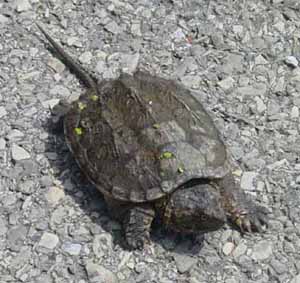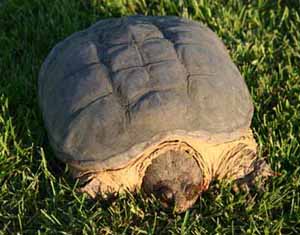Snapping Turtle - Chelydra serpentina
The common and familiar snapping turtle is North America's second largest freshwater turtle - the alligator snapping turtle is the largest. The snapping turtle has a large head, long tail and a short temper. Snapping turtles are so named because they defend themselves by snapping and biting aggressively when handled or otherwise bothered - the small turtle pictured here did just that when I encountered it. They are apex predators in their environment and are important in most aquatic ecosystems. They not only are hunters they are scavengers and help clean up dead animals. They are most common in large, permanent, quiet bodies of water, such as ponds, lakes, swamps, canals and rivers. More aquatic than most of our turtles, they seldom bask but often swim near the surface.
Snapping turtles are fairly common around ponds, slow rivers and lakes. They are not currently listed under any category of special protection. Commercial collecting of snapping turtles for their meat has probably reduced populations in some areas, and in some states such activities have resulted in the need for protective legislation. When I get a chance to see one of these turtle floating just under the water, I count that as a good day.
When closely approached on land, a snapping turtle often elevates its hindquarters, gapes its jaws and then lunges. They may also secrete a strong-smelling musk from glands along the sides of the body when irritated. In water they are less aggressive, usually retreating or withdrawing when confronted by larger animals.
Snapping turtles can large so unless you have space - and a lot of it - do not try and maintain one as a pet. It is not fair to keep a young one with the ultimate intention of releasing it when it grows too large. By doing so, you not only would do a disservice to the turtle but also to the environment. One main reason is that they may carry bacteria or fungus that can affect the wild population. Additionally, after being maintained as a pet, the turtle may have difficulty adjusting to defending itself, fending for food and acclimating to changing seasons!! Do to its size, food needs and temperament, I consider this an advanced pet and only serious herpetologists should consider the snapping turtle a pet. These are pets best kept alone.
Average Size - Snapping turtles can grow to 18" - 20" with a total weight of 45 pounds. There are records of some captive snapping turtles exceeding 70 pounds.
Life Span - The life span of snapping turtles can exceed 40 years.
Diet - In the wild, much of their food is scavenged, and vegetation comprises a high percentage of their diet. The meat part of their diet is comprised of invertebrates, fish, amphibians, reptiles, birds, mammals and carrion. In captivity, they will eat similar foods. Turtle pellets provide necessary vitamins and mineral supplements that are necessary for your turtles health.
Feeding - Feeding should be at most every other day. Provide a varied diet. Dusting the food at least once each week with a calcium/vitamin supplement is important. Special food formulated for turtles can be used, but this should not make up any more than 25% of the total diet. Another 25% of the diet should be made up of animal protein, and can include live feeder fish, earthworms, crickets, waxworms, cooked chicken or lean beef, and aquatic snails. Young turtles can be feed small feeder items such as blood worms, shrimp, dapnia and krill. The remainder of the diet (up to about 60% of the adult diet) should be made up of fresh greens, vegetable, and fruits. Good choices for greens include collard, mustard and dandelion greens, butter lettuce and other leaf lettuces (but never iceberg lettuce - it has little nutritional value). Carrots (tops are fine too), squash and green beans can be shredded and offered. Fresh fruits can be given too, shredding hard fruit like apples and chopping softer fruits such as bananas and berries. Make sure to clean out any food that is not eaten within 1/2 hour of feeding.
Housing - For young snapping turtles, a twenty gallon tank is fine. Mature snapping turtles should be kept in at least a small child pool. They need the room to move around in and an area large enough to bask on.
Substrate - Should be made up of gravel (large) for water area, soil, gravel (small) for land/basking areas
 Temperature - A submersible heater should be used to keep the water at 75-86 degrees F. Get a good aquarium thermometer and monitor the water temperature. Protect the heater and thermometer from the turtle by placing it behind something or covering it in screening so the turtles can't move them or try and eat them. Temperature - A submersible heater should be used to keep the water at 75-86 degrees F. Get a good aquarium thermometer and monitor the water temperature. Protect the heater and thermometer from the turtle by placing it behind something or covering it in screening so the turtles can't move them or try and eat them.
A heated spot should be provided in the basking area.An incandescent bulb, spotlight or ceramic heater can serve this purpose, but make sure there is no way the turtle can touch the light or that the light can fall into the water. The temperature at the basking spot should be 85 - 88 F. Watch the water temperature when the basking light is on as it may heat the water. You can let the temerature drop by 10 degrees F at night.
Description - The carapace (top) is tan to dark brown. Three rows of weak to prominent keels run the length of the shell. The plastron (bottom of the turtle) is usually yellow to tan. The tail is typically as long as the carapace with saw toothed keels. The snapping turtle cannot totally withdraw its head. Its neck is extremely long and muscular. There is no mistaking this turtle.
Lighting - In addition to the basking light, a full spectrum reptile light should be provided. Exposure to full spectrum lighting is necessary for proper calcium metabolism. It is also nice to take your turtle out into natural sunlight in warmer weather.
Recommended Supplies:
- Habitat with secure lid
- Thermometer
- Humidity gauge
- Book about turtles
- Light timer
|
- Substrate
- Undertank heat source
- Incandescent light or ceramic heater
- Full spectrum lighting source
- Filtration system
|
Habitat Maintenance Change at least 1/2 the water twice weekly. Thoroughly clean the tank/pool at least once a week: set turtle aside in a secure habitat (good luck!!); scrub the tank and furnishings with a 3% bleach solution; rinse thoroughly with water, removing all smell of bleach; dry the tank and furnishings; and add clean substrate
Grooming and Hygiene Don't handle unless necessary; wear latex gloves. Wash your hands after handling the habitat contents to help prevent Salmonella and other infectious diseases.
Filtration One of the most common problems with keeping an aquatic turtle is keeping the water clean. Dirty water carries bacterial and parasitic diseases - it also stinks. Regular water changes as described above are one way of doing this. Another method is to use a filter system similar to one that would be used for a fish tank. Even if you implement a filtration system, you will need to replace at least 25% of the water each week and fully change the water once every other week. Ammonia, nitrates, nitrites and bacteria will still buildup causing health problems. These are available in three main types:
Undergravel filters I would not use an undergravel filter. They are meant to create a biological filtration system in lightly stocked fish tanks. They do not clean out waste, rather they draw waste down into the gravel and ultimately below the gravel. They need periodic total breakdowns - and that is a pain. Even if you use reverse (powerhead blowing water under the filter which then comes up through the gravel) in my estimation it just is not worth it.
Internal canister filters These are relatively cheap and can be highly effective. Use the largest size you can install in your tank. The best filter medium is foam. This can be taken out and washed whenever it becomes clogged.
External canister filters For large tanks/pools - this filter is superior. The filter and pump are outside the water, only the inlet and outlet tubes are exposed in the water.
Signs of a Healthy Pet:
- Clear eyes
- Clear nose and mouth
- Active and alert
|
- Eats regularly
- Healthy skin and hard shell
| Common Health Issues and Red Flags:
- Vomiting
- Discharge in nose or mouth
- Lethargy
|
- Abnormal feces
- Decreased appetite
- Cloudy eyes
| If you notice any of these signs, please contact your exotic animal veterinarian.
As with all pets in this category, it is important that you find a veterinarian that practices in EXOTICS – this is critical. The typical small animal practitioner may not have sufficient knowledge in this area.
Even this guide is general in nature and should not be used to diagnose your pet.
|



 Temperature - A submersible heater should be used to keep the water at 75-86 degrees F. Get a good aquarium thermometer and monitor the water temperature. Protect the heater and thermometer from the turtle by placing it behind something or covering it in screening so the turtles can't move them or try and eat them.
Temperature - A submersible heater should be used to keep the water at 75-86 degrees F. Get a good aquarium thermometer and monitor the water temperature. Protect the heater and thermometer from the turtle by placing it behind something or covering it in screening so the turtles can't move them or try and eat them.